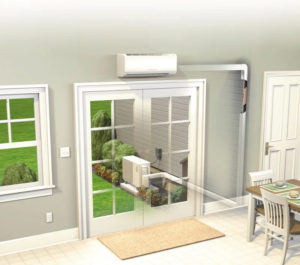Four Benefits Of Ductless Cooling For Third Floors and Attics

Four Benefits of Ductless Cooling for Third Floors and Attics
If you’re tired of that third floor or attic never feeling comfortable in the summer, then it’s time to consider ductless cooling.
Ductless systems, or mini splits, have become much more common in the United States over the past decade. And, when it comes to isolating a problem area in your home, they’re the best bet out there.
In this article, we’ll explain how these systems work. We’ll also see how they compare to central air and portable cooling solutions. And, overall, we’ll go through the benefits for your home.
How Ductless Cooling Works
Ductless cooling systems are often called “mini splits” because they consist of two major components. First is the air handler that we permanently install in the room you’re treating. Then, there’s a heat pump outside.
All we need is a small lineset that connects the two. Heat and cooled air travel through a narrow refrigerant line. That’s opposed to forced air through ducts or directly through a bulky portable AC or window unit.
The air handler draws in warm, humid air from the room. It dehumidifies it, sending the water vapor down a condensate line.
Then, the heat, or thermal energy, travels through the refrigerant to the heat pump, which expels it outside.
Meanwhile, that lineset is only a few inches around. For a one-room mini split, we usually run it behind the air handler through the wall.
Then, the heat pump is outside almost directly below. We connect the two and can use a line hide that matches the color of your home.
Four Benefits of Ductless Cooling for Attics and Third Floors
- No Costly Ductwork Installation
- Quiet, Efficient Operation
- Lower Energy Bills
- Supplemental Heat
Let’s see how these all work.
No Costly Ductwork Installation
This is a huge advantage if you don’t have central air. Or, if it doesn’t extend to your third floor. Adding new ductwork is very expensive. The cost includes designing, fabricating, and installing the new system.
And, those ducts will take up a lot of room. That means giving up some living area in a part of the house that’s usually not as spacious as downstairs.
This way, however, you avoid that expense and hassle.
Quiet, Efficient Operation
Next is how well — and how silently — these systems operate.
First of all, an air handler produces less than 30 decibels of sound. That means it’s quieter than regular conversation, and certainly softer than a window unit or even a forced air system.
For many homes, especially older ones, the third floor has less living space than upstairs. It may be a dormer room with a sloped ceiling. Or, it’s only above one part of the house.
Either way, you can’t stay as far away from your cooling system as you can in other parts of your home. That makes it more likely that a loud air conditioner makes it hard to hold a conversation or watch TV.
But, an air handler makes about as much sound as rustling leaves outside. You won’t hear a thing unless you’re directly underneath it with nothing else making noise.
Lower Energy Bills
Even with all these features, a mini split actually has much less of an impact on your electric bill than portable units or even central air.
While the upfront cost may be higher — it costs around $4,000 to install for one area of your home — when you factor in the superior comfort and lower energy bills, everything more than balances out.
The difference here is inverter technology.
Your traditional AC stays off until the room gets too hot. Then, it turns on too cool it back down. It’s worked for decades, but it’s a little wasteful.
The system’s always doing extra work, because the room is hotter than you want it. Plus, all that stopping and starting adds a lot of wear and tear. And, that leads to problems and breakdowns.
Instead, your mini split spends most of the time in a low-power mode. It keeps the temperature steady, which requires less work and less electricity.
Next, the unit’s sensors detect hot spots in the room, and the fans can direct the treated air directly where it’s needed.
That means the room gets cooler faster — and stays that way. Plus, if your attic has some nooks and crannies, the fans can “get around” them to keep the whole floor comfortable.
Supplemental Heat
You can consider supplemental heat a bonus feature that traditional cooling can’t offer.
The heat transfer process we talked about before also works in the opposite direction: The heat pump can draw in thermal energy from the outdoors and send it up to the air handler.
Odds are, the third floor of your home gets colder before the first and second stories. And, it probably stays chilly even when other parts of the house are warm.
With ductless, you can add some extra heat to the attic before it’s cold enough for you to begin using your furnace for the winter.
The same goes for early spring, when you just need a little kick to keep things comfortable up there.
Your standard heat pump can provide heat even when the temperature outside is in the 20s. It amplifies what little thermal energy is out there until it’s enough to keep you warm.
After that, you can opt for a Hyper Heat model that can provide heating even when it’s negative 13 degrees outside.
If you want to learn more about how a mini split can make the third floor or attic in your Jersey Shore home much more comfortable without driving up your electric bill, call or email us here at Broadley’s.








